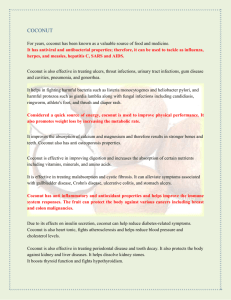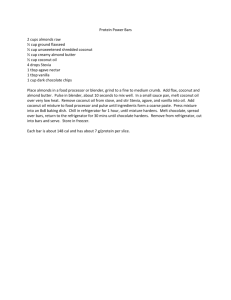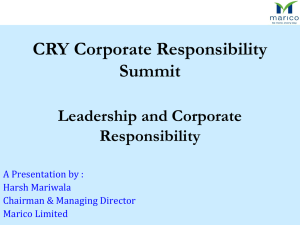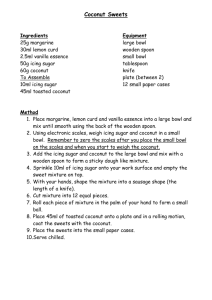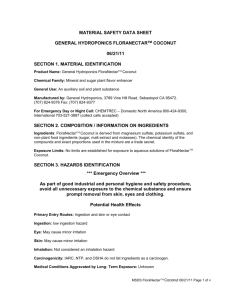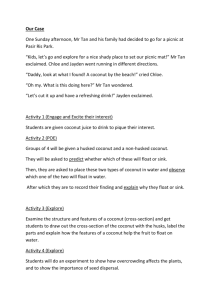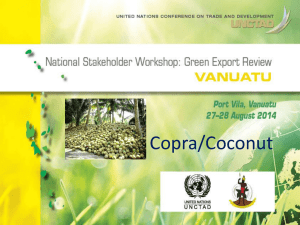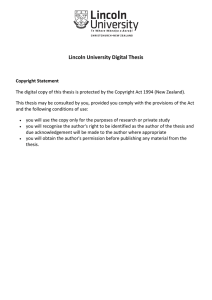Coconut industry – structure and organization Coconut tree is
advertisement
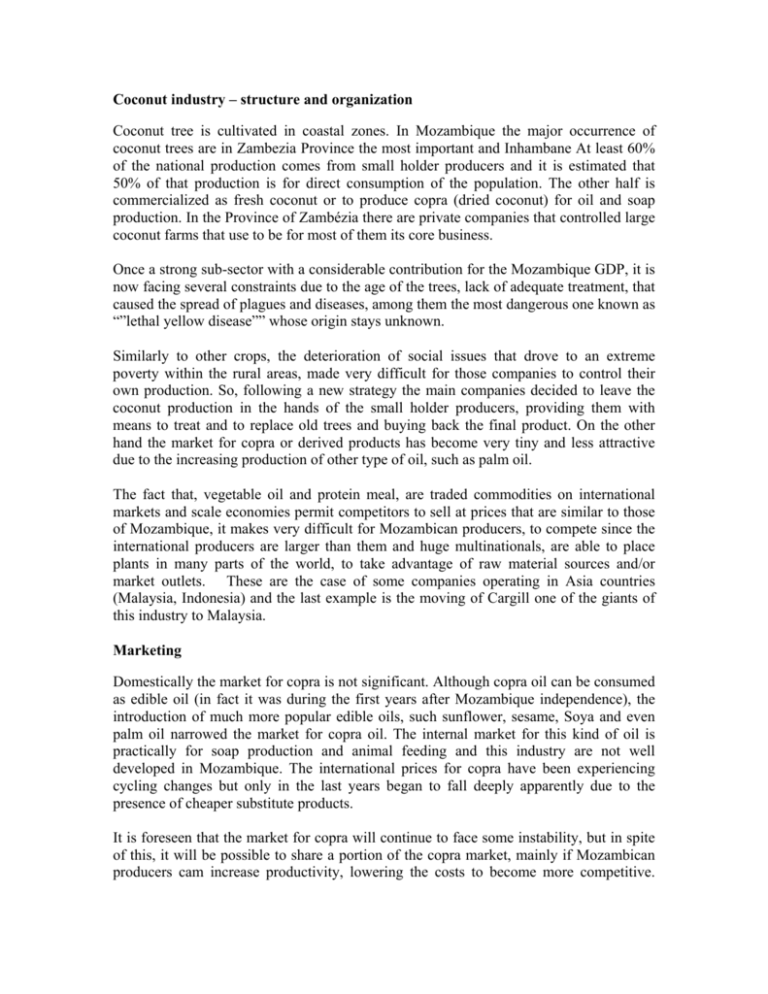
Coconut industry – structure and organization Coconut tree is cultivated in coastal zones. In Mozambique the major occurrence of coconut trees are in Zambezia Province the most important and Inhambane At least 60% of the national production comes from small holder producers and it is estimated that 50% of that production is for direct consumption of the population. The other half is commercialized as fresh coconut or to produce copra (dried coconut) for oil and soap production. In the Province of Zambézia there are private companies that controlled large coconut farms that use to be for most of them its core business. Once a strong sub-sector with a considerable contribution for the Mozambique GDP, it is now facing several constraints due to the age of the trees, lack of adequate treatment, that caused the spread of plagues and diseases, among them the most dangerous one known as “”lethal yellow disease”” whose origin stays unknown. Similarly to other crops, the deterioration of social issues that drove to an extreme poverty within the rural areas, made very difficult for those companies to control their own production. So, following a new strategy the main companies decided to leave the coconut production in the hands of the small holder producers, providing them with means to treat and to replace old trees and buying back the final product. On the other hand the market for copra or derived products has become very tiny and less attractive due to the increasing production of other type of oil, such as palm oil. The fact that, vegetable oil and protein meal, are traded commodities on international markets and scale economies permit competitors to sell at prices that are similar to those of Mozambique, it makes very difficult for Mozambican producers, to compete since the international producers are larger than them and huge multinationals, are able to place plants in many parts of the world, to take advantage of raw material sources and/or market outlets. These are the case of some companies operating in Asia countries (Malaysia, Indonesia) and the last example is the moving of Cargill one of the giants of this industry to Malaysia. Marketing Domestically the market for copra is not significant. Although copra oil can be consumed as edible oil (in fact it was during the first years after Mozambique independence), the introduction of much more popular edible oils, such sunflower, sesame, Soya and even palm oil narrowed the market for copra oil. The internal market for this kind of oil is practically for soap production and animal feeding and this industry are not well developed in Mozambique. The international prices for copra have been experiencing cycling changes but only in the last years began to fall deeply apparently due to the presence of cheaper substitute products. It is foreseen that the market for copra will continue to face some instability, but in spite of this, it will be possible to share a portion of the copra market, mainly if Mozambican producers cam increase productivity, lowering the costs to become more competitive. Meanwhile it will be wise to explore the huge potentiality of the coconut tree from which several products with interesting market can be taken. Prospects for Mozambique coconut industry Several products can become an excellent and profitable business, when exploited in a commercial basis, among them it can be mentioned: Coconut processing options: Óil Copra Fresh coconut pulp Soap Cake Desiccated Coconut Coconut cream COCUNUT Hard Shell Charcoal Coconut stem Timber Products Coconut h ll shell Traditional products Fiber Fibra teçelada Tissue Pulp Turfa Turf New products Copra: Is the part of the coconut that can be consumed, after being treated in a drier or under the sun. Compared with the other coconut products is the one that as less value added and can be used to produce oil, soap or cake for animal feeding. Mozambique is presently copra exporter. The present copra processing capacity is higher than the available product. Desiccated coconut: It is also the part that can be consumed but treated in very strict hygiene conditions. It has a high value in the market. The South African market imports annually about 3 0000 tones from Philippines and Sri-Lanka and Mozambique due to its localization can take over that market. Coconut cream: It is also a very high value product but it is much more difficult to prepare. It has a smaller market than desiccated coconut. Charcoal: The coconut shell is used to produce activated charcoal. It is considered to be a charcoal of high quality due to its consistency. There is a special technology to produce activated charcoal, but it needs significant investments. It has an important market. Saw timber: There is a huge quantity of old trees without enough productivity that can be used as timber and it is envisaged that in the near future a significant number of trees will die from yellow disease. The increasing market for wood products can be a great opportunity for this kind of business. However due to the fact that it is a relatively new product the re are some risks to enter the market. Turf: Turf after being treated can origin to types of products, the long fiber and the spongy fiber. This occurs in a single process, through where the fiber is separated cleaned and used to produce several products (ropes, straw mats etc.) while the spongy fiber is compacted and sold as turf to be used mainly in horticulture industry. Tariff considerations and possible constraints Coconut is included within SADC agriculture and processed products tariff release and it is previewed that by the year 2015 no more tax will be charged for coconut imports. The below mentioned table shows how the release will happen. Product Tariffs Import tax phasing Year 2002 2003 2005 2008 2011 2012 Coconut (RSA) 30 25 20 15 13 (Others) 30 25 20 5 0 Notas: RSA stands for South Africa Republic and others the remaining countries. For all exported products VAT does not apply. VAT 2015 0 17 17
